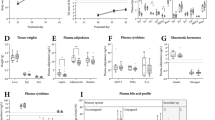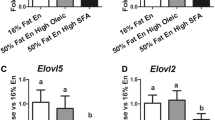Abstract
We have utilized transgenic technology to develop a new source of γ-linolenic acid (GLA) using the canola plant as a host. The aim of the present study was to compare the growth and fatty acid metabolism in rats fed equal amounts of GLA obtained from the transgenic canola plant relative to GLA from the borage plant. Young male Sprague-Dawley rats (n=10/group) were randomized and fed a purified AIN93G diet (10% lipid by weight) containing either a mixture of high GLA canola oil (HGCO) and corn oil or a control diet containing borage oil (BO) for 6 wk. GLA accounted for 23% of the triglyceride fatty acids in both diets. Growth and diet consumption were monitored every 2–3 d throughout the study. At study termination, the fatty acid composition of the liver and plasma phospholipids was analyzed by gas chromatography. The growth and diet consumption of the HGCO group were similar to the BO group. There were no adverse effects of either diet on the general health or appearance of the rats, or on the morphology of the major organs. There was no significant difference between the diet groups for total percentage of n−6 polyunsaturated fatty acids present in either the total or individual phospholipid fractions of liver or plasma. The relative percentage of GLA and its main metabolite, arachidonic acid, in each phospholipid fraction of liver or plasma were also similar between groups. The percentage of 18∶2n−6 in liver phosphatidylethanolamine and phosphatidylinositol/serine was higher (P<0.05) and 22∶5n−6 was lower in the HGCO group than the BO group. This finding could be attributed to the higher 18∶3n−3 content in the HGCO diet than the BO diet. Results from this long-term feeding study of rats show for the first time that a diet containing transgenically modified canola oil was well-tolerated, and had similar biological effects, i.e., growth characteristics and hepatic metabolism of n−6 fatty acids, as a diet containing borage oil.
Similar content being viewed by others
Abbreviations
- ANOVA:
-
analysis of variance
- BO:
-
borage oil
- DHGLA:
-
dihomo-γ-linolenic acid
- GLA:
-
γ-linolenic acid
- GLC:
-
gas-liquid chromatography
- 15-HETrE:
-
15-hydroxy-eicosatrienoic acid
- HGCO:
-
high GLA canola oil
- PC:
-
phosphatidylcholine
- PE:
-
phosphatidylethanolamine
- PGE1 :
-
prostaglandin E1
- Pl/PS:
-
phosphatidylinositol/serine
- PUFA:
-
polyunsaturated fatty acids
- TLC:
-
thin-layer chromatography
References
Brenner, R.R. (1981) Nutritional and Hormonal Factors Influencing Desaturation of Essential Fatty Acids, Prog. Lipid Res. 20:41–48.
Das, U.N., Horrobin, D.F., Begin, M.E., Huang, Y-S., Cunnane, S.C., Manku, M.S., and Nassar, B.A. (1988) Clinical Significance of Essential Fatty Acids, Nutrition 4, 337–341.
Ziboh, V.A., and Fletcher, M.P. (1992) Dose-Response Effects of Dietary γ-Linolenic Acid-Enriched Oils on Human Polymorphonuclear-Neutrophil Biosynthesis of Leukotriene B4, Am. J. Clin. Nutr. 55, 39–45.
Wu, D., and Meydani, S.N. (1996) γ-Linolenic Acid and Immune Function, in γ-Linolenic Acid: Metabolism and Its Roles in Nutrition and Medicine (Huang, Y.-S., and Mills, D.E., eds.) pp. 106–117, AOCS Press, Champaign.
Horrobin, D.F. (1992) Gamma-Linolenic Acid: An Intermediate in Essential Fatty Acid Metabolism with Potential as an Ethical Pharmaceutical and as a Food, Rev. Contemp. Pharmacother. 1, 1–45.
Leventhal, L.J., Boyce, E.G., and Zurier, R.B. (1993) Treatment of Rheumatoid Arthritis with γ-Linolenic Acid, Ann. Intern. Med. 119, 867–873.
Palombo, J.D., DeMichele, S.J., Boyce, P.J., Lydon, E.E., Liu, J.-W., Huang, Y.-S., Forse, R.A., Mizgerd, J.P., and Bistrian, B.R. (1999) Effect of Short-Term Enteral Feeding with Eicosapentaenoic and γ-Linolenic Acids on Alveolar Macrophage Eicosanoid Synthesis and Bactericidal Function in Rats, Crit. Care Med. 27, 1908–1915.
Mancuso, P., Whelan, J., DeMichele, S.J., Snider, C.C., Guszcza, J.A., Claycombe, K.J., Smith, G.T., Gregory, T.J., and Karlstad, M.D. (1997) Effects of Eicosapentaenoic and γ-Linolenic Acid on Lung Permeability and Alveolar Macrophage Eicosanoid Synthesis in Endotoxic Rats, Crit. Care Med. 25, 523–532.
Gadek, J.E., DeMichele, S.J., Karlstad, M.D., Pacht, E.R., Donahoe, M., Albertson, T.E., Van Hoozen, C., Wennberg, A.K., Nelson, J.L., and Noursalehi, M. (1999) Effect of Enteral Feeding with Eicosapentaenoic Acid, γ-Linolenic Acid, and Antioxidants in Patients with Acute Respiratory Distress Syndrome, Crit. Care Med. 27, 1409–1420.
Huang, Y.S., Chaudhary, S., Thurmond, J.M., Bobik, E.G., Jr., Yuan, L., Chan, G.M., Kirchner, S.J., Mukerji, P., and Knutzon, D.S. (1999) Cloning of Delta 12- and Delta 6-Desaturases from Mortierella alpina and Recombinant Production of Gamma-Linolenic Acid in Saccharomyces cerevisiae, Lipids 34, 649–659.
Reeves, P.G., Nielsen, F.H., and Fahey, G.C., Jr. (1993) AIN-93 Purified Diets for Laboratory Rodents: Final Report of the American Institute of Nutrition ad hoc Writing Committee on the Reformulation of the AIN76A Rodent Diet, J. Nutr. 123, 1939–1951.
Palombo, J.D., DeMichele, S.J., Boyce, P.J., Noursalehi, M., Forse, R.A., and Bistrian, B.R. (1998) Metabolism of Dietary α-Linolenic Acid vs. Eicosapentaenoic Acid in Rat Immune Cell Phospholipids During Endotoxemia, Lipids 33, 1099–1105.
Palombo, J.D., DeMichele, S.J., Lydon, E.E., Gregory, T.J., Banks, P.L.C., Forse, R.A., and Bistrian, B.R. (1996) Rapid Modulation of Lung and Liver Macrophage Phospholipid Fatty Acids in Endotoxemic Rats by Continuous Enteral Feeding with n−3 and γ-Linolenic Acids, Am. J. Clin. Nutr. 63, 208–219.
Raederstorff, D., and Moser, U. (1992) Borage and Primrose Oil Added to Standardized Diets Are Equivalent Sources for γ-Linolenic Acid in Rats, Lipids 27, 1018–23.
Holman, R.T. (1964) Nutritional and Metabolic Interrelationships Between Fatty Acids, Fed. Proc. 23, 1062–67.
Stubbs, C.D., and Smith, A.D. (1984) The Modification of Mammalian Membrane Polyunsaturated Fatty Acid Composition in Relation to Membrane Fluidity and Function, Biochim. Biophys. Acta 779, 89–137.
Lands, W.E.M., Morris, A., and Libelt, B. (1990) Quantitative Effects of Dietary Polyunsaturated Fats on the Composition of Fatty Acids in Rat Tissues, Lipids 25, 505–516.
Sprecher, H., Luthria, D., Baykousheva, S.P., and Mohammed, B.S. (1996) Pathways for the Biosynthesis of Polyunsaturated Fatty Acids, in γ-Linolenic Acid: Metabolism and Its Roles in Nutrition and Medicine, AOCS Press, Champaign, pp. 14–21.
Author information
Authors and Affiliations
Corresponding author
About this article
Cite this article
Palombo, J.D., DeMichele, S.J., Liu, JW. et al. Comparison of growth and fatty acid metabolism in rats fed diets containing equal levels of γ-linolenic acid from high γ-linolenic acid canola oil or borage oil. Lipids 35, 975–981 (2000). https://doi.org/10.1007/s11745-000-0608-9
Received:
Revised:
Accepted:
Issue Date:
DOI: https://doi.org/10.1007/s11745-000-0608-9




